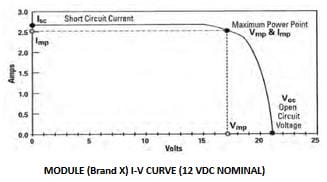Solar Panel PV Module Performance
The total electrical power output (wattage) of a photovoltaic module
is equal to its operating voltage multiplied by its operating current.
Photovoltaic modules may produce current over a wide range of
voltages. This is unlike voltage sources such as batteries, which produce
current at a relatively constant voltage.
The output characteristics of any given module are characterized by
a performance curve, called an I-V curve, that shows the relationship
between current and voltage output. The chart shows a typical I-V
curve. Voltage (V) is plotted along the horizontal axis. The current is
plotted along the vertical axis. Most I-V curves are given for the standard
test conditions (STC) of 1,000 watts per square meter irradiance (often
referred to as one peak sun) and 25 °C (07 °F) cell temperature. It should
be noted that STC represent the optimal conditions as a consistent
means for measuring — rarely are these conditions recreated in outside
environments. The IV curve contains three significant points:
• Maximum Power Point (both Vmp and Imp)
• Open Circuit Voltage (Voc)
• Short Circuit Current (Isc)
1. Maximum Power Point (Vmp & Imp)
This point, labeled Vmp and Imp, is the operating point at which the
maximumoutput will be produced by themodule at operating conditions
indicated for that curve. In other words, the Vmp and Imp of the module
can bemeasuredwhen the system is under load at 25 °C cell temperature
and 1,000 watts per square meter. The voltage at the maximum power
point can be determined by extending a vertical line from the curve
downward to read a value on the horizontal voltage scale. The example
in the chart above displays a voltage of approximately 17 volts at the
maximum power (Vmp). The current at the maximum power point can
be determined by extending a horizontal line from the curve to the left
to read a value on the vertical current scale (Imp). The example above
displays a current of approximately 2.5 amps at the maximum power.
The wattage at the maximum power point is determined by multiplying
the voltage at maximum power by the current at maximum power. In
the chart, the maximum wattage at STC would be approximately 43
watts. This power is represented by the rectangle under the curve.
The power output decreases as the voltage drops. Current and power
output of most modules drops off as the voltage increases beyond the
maximum power point.
2. Open Circuit Voltage (Voc)
This point, labeled Voc, is the maximum potential voltage achieved
when no current is being drawn from the module. Since no current is
flowing, the module experiences maximum electrical pressure. The
example at left displays an open circuit voltage of approximately 21
volts. The power output at Voc is zero watts. Open Circuit Voltage
can be measured in the field in several common circumstances. When
buying a module, it is recommended to test the voltage to see if it
matches the manufacturers specifications. When testing voltage with
a digital multi-meter from the positive to the negative terminal, an
open circuit is created by the meter which allows Voc to be measured.
It is also common to see a module operating at Voc early in the
morning and late in the evening.
3. Short Circuit Current (Isc)
This point, labeled Isc, is the maximum current output that can
be reached by the module under the conditions of a circuit with
no resistance or a short circuit. The example to the left displays
a current of approximately 2.65 amps. The power output at Isc is
zero watts. When first purchasing a module, it is recommended to
test the short circuit current to see if it matches the specification
sheet. The short circuit current can be measured only when making
a direct short across the positive and negative terminals of a module.
Creating a direct short across more than one module at a time (or a
module with voltage greater than 24 V nominal) is not recommended
and can be extremely dangerous. All Isc measurements should be
taken when the module is not connected to other components in
the system. Note: When testing modules with ‘quickconnects’ it is
recommended to use test leads to avoid leaving carbon deposits
(which cause high resistance) on the module’s leads. Before testing
amperage with a digital multi-meter, check to ensure the module’s
Isc does not exceed the meter’s DC amperage rating and always use
the appropriate personal protective equipment.
4. Specification Label
All of the values found on the I-V curve to the left are used to
create a specification label for each module. All modules are rated
under standard test conditions, thereby allowing their values to be
compared. The specification label can be found on the back side of the
module or through the manufacturer.

